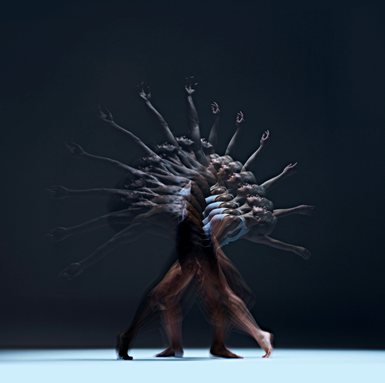The first new production the Czech National Ballet will present in the current season is the mixed bill Timeless
 The first new production to be presented by the Czech National Ballet in the current season is the mixed bill Timeless, scheduled to receive its premiere on 20 October 2017. It is made up of three choreographies. The first of them, George Balanchine’s Serenade, and the final one, Glen Tetley’s Le sacre du printemps, rank among the most celebrated ballet works. The second, Separate Knots, is a piece directly created for the Czech National Ballet by the Israeli choreographer Emanuel Gat to Fryderyk Chopin’s music.
The first new production to be presented by the Czech National Ballet in the current season is the mixed bill Timeless, scheduled to receive its premiere on 20 October 2017. It is made up of three choreographies. The first of them, George Balanchine’s Serenade, and the final one, Glen Tetley’s Le sacre du printemps, rank among the most celebrated ballet works. The second, Separate Knots, is a piece directly created for the Czech National Ballet by the Israeli choreographer Emanuel Gat to Fryderyk Chopin’s music.Serenade, dating from 1933, is a masterpiece by the inspired choreographer George Balanchine, who ushered in a new ballet style, which today is referred to as neoclassicism. Born in Saint Petersburg, he studied at the Imperial Ballet School and gained invaluable experience with Sergey Diaghilev’s famous Les Ballets Russes in Paris. In 1933, upon the invitation of Lincoln Kirstein, Balanchine moved to New York, where he founded the School of American Ballet and, later on, formed the New York City Ballet, one of the world’s most distinguished dance companies.
Mr. B., as Balanchine has been dubbed, created some 425 choreographies. Reputedly, he conceived his pieces with a lightness and ease, amidst a peaceful and amicable atmosphere, with the variations coming into being directly at the studio, inspired by the dancers themselves. A case in point is Serenade, which Balanchine subjected to numerous revisions, improvements and “complications”, in line with the performers’ increasing mastery. Extraordinary forcible is the very beginning of Serenade, whereby, following the curtain rise, 17 dancers stand motionless on the stage. Coming across as a beautiful picture, the audience perceives their absolute calm, with the atmosphere being underlined by Tchaikovsky’s slowly unfurling Serenade for Strings in C. Balanchine’s opus may be compared to a flowing river, evoking as it does a variety of moods, colours, with the motion becoming ever more dynamic with the swelling stream of the choreography itself. A visual representation of music, it affords a wonderful dance experience.
The third piece, Glenn Tetley’s choreography Le sacred du printemps, will be staged at the National Theatre in Prague for the very first time. Born in Cleveland, Tetley studied medicine, yet he changed course after he had attended a performance of the ballet Romeo and Juliet, choreographed by Anthony Tudor. He duly abandoned medicine and went on to launch an illustrious career as a dancer, performing with companies of such renown as the American Dance Theatre, the Martha Graham Dance Company, the Nederland Dans Theatre and others, also working as a choreographer and artistic director. Tetley strove to fuse classical ballet and modern dance; he loved purity and precise shape. Representing a great challenge for the performers, his works place enormous physical requirements on them. And Le sacre du printemps is no exception in this respect, with the dancers reaching the very physical limits at the end of the piece.
The history of Tetley‘s Le sacre du printemps has been linked with outstanding figures. The first performance was carried out in an intimate milieu, accompanied by two pianos, played by Stravinsky himself and his no less famed friend, the composer Claude Debussy. Tetley created his adaptation of Le sacre du printemps in 1974 for the Bavarian State Ballet. The work was referred to with great humility and admiration for the sophisticated choreography by Mikhail Baryshnikov, who danced the lead role at the American Ballet Theatre in 1976. Ever since that time, Tetley’s Le sacre du printemps has never ceased to be staged regularly worldwide.
The opening night of Timeless will be of a truly festive nature not only owing to its presenting the first performance of Tetley’s Le sacre du printemps in the Czech Republic, but also thanks to its including the world premiere of Emanuel Gat’s Separate Knots. The renowned Israeli choreographer has worked with such prominent companies as the Paris Opera Ballet, Sydney Dance Company, Ballet National de Marseille, Royal Swedish Ballet, Polish National Ballet, Ballet de Lorraine … This will be Gat’s debut work with the Czech National Ballet.
The ballet Separate Knots is accompanied by the captivating strains of Fryderyk Chopin. Gat himself has referred to music as merely one of the sources of his inspiration. “I do not make choreography to illustrate music. Choreography is an independent form of thought and expression, and it has more important roles than to be inspired by music,” Emanuel Gat said, adding: “I would say that I’m closer to choreography which is structure-based than effect- or concept-oriented. I’m after a choreographic process that is a sort of space in which the dancers can fully express themselves and bring their individuality forward.”
Source: National Theater


